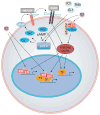The G-protein-coupled estrogen receptor GPER in health and disease
- PMID: 21844907
- PMCID: PMC3474542
- DOI: 10.1038/nrendo.2011.122
The G-protein-coupled estrogen receptor GPER in health and disease
Abstract
Estrogens mediate profound effects throughout the body and regulate physiological and pathological processes in both women and men. The low prevalence of many diseases in premenopausal women is attributed to the presence of 17β-estradiol, the predominant and most potent endogenous estrogen. In addition to endogenous estrogens, several man-made and plant-derived molecules, such as bisphenol A and genistein, also exhibit estrogenic activity. Traditionally, the actions of 17β-estradiol are ascribed to two nuclear estrogen receptors (ERs), ERα and ERβ, which function as ligand-activated transcription factors. However, 17β-estradiol also mediates rapid signaling events via pathways that involve transmembrane ERs, such as G-protein-coupled ER 1 (GPER; formerly known as GPR30). In the past 10 years, GPER has been implicated in both rapid signaling and transcriptional regulation. With the discovery of GPER-selective ligands that can selectively modulate GPER function in vitro and in preclinical studies and with the use of Gper knockout mice, many more potential roles for GPER are being elucidated. This Review highlights the physiological roles of GPER in the reproductive, nervous, endocrine, immune and cardiovascular systems, as well as its pathological roles in a diverse array of disorders including cancer, for which GPER is emerging as a novel therapeutic target and prognostic indicator.
Conflict of interest statement
E. R. Prossnitz declares US patent number 7,875,721. M. Barton declares no competing interests.
Figures



Similar articles
-
International Union of Basic and Clinical Pharmacology. XCVII. G Protein-Coupled Estrogen Receptor and Its Pharmacologic Modulators.Pharmacol Rev. 2015 Jul;67(3):505-40. doi: 10.1124/pr.114.009712. Pharmacol Rev. 2015. PMID: 26023144 Free PMC article. Review.
-
Does GPER Really Function as a G Protein-Coupled Estrogen Receptor in vivo?Front Endocrinol (Lausanne). 2020 Mar 31;11:148. doi: 10.3389/fendo.2020.00148. eCollection 2020. Front Endocrinol (Lausanne). 2020. PMID: 32296387 Free PMC article. Review.
-
What have we learned about GPER function in physiology and disease from knockout mice?J Steroid Biochem Mol Biol. 2015 Sep;153:114-26. doi: 10.1016/j.jsbmb.2015.06.014. Epub 2015 Jul 16. J Steroid Biochem Mol Biol. 2015. PMID: 26189910 Free PMC article. Review.
-
Expression and Role of the G Protein-Coupled Estrogen Receptor (GPR30/GPER) in the Development and Immune Response in Female Reproductive Cancers.Front Endocrinol (Lausanne). 2020 Aug 20;11:544. doi: 10.3389/fendo.2020.00544. eCollection 2020. Front Endocrinol (Lausanne). 2020. PMID: 32973677 Free PMC article. Review.
-
Minireview: G protein-coupled estrogen receptor-1, GPER-1: its mechanism of action and role in female reproductive cancer, renal and vascular physiology.Endocrinology. 2012 Jul;153(7):2953-62. doi: 10.1210/en.2012-1061. Epub 2012 Apr 11. Endocrinology. 2012. PMID: 22495674 Free PMC article. Review.
Cited by
-
Synthesis and characterization of tricarbonyl-Re/Tc(I) chelate probes targeting the G protein-coupled estrogen receptor GPER/GPR30.PLoS One. 2012;7(10):e46861. doi: 10.1371/journal.pone.0046861. Epub 2012 Oct 15. PLoS One. 2012. PMID: 23077529 Free PMC article.
-
Hetero-oligomeric Complex between the G Protein-coupled Estrogen Receptor 1 and the Plasma Membrane Ca2+-ATPase 4b.J Biol Chem. 2015 May 22;290(21):13293-307. doi: 10.1074/jbc.M114.628743. Epub 2015 Apr 6. J Biol Chem. 2015. PMID: 25847233 Free PMC article.
-
Emerging roles of GPER in diabetes and atherosclerosis.Trends Endocrinol Metab. 2015 Apr;26(4):185-92. doi: 10.1016/j.tem.2015.02.003. Epub 2015 Mar 9. Trends Endocrinol Metab. 2015. PMID: 25767029 Free PMC article. Review.
-
Obesity and Cancer: 27-Hydroxycholesterol, the Missing Link.Int J Mol Sci. 2020 Jul 8;21(14):4822. doi: 10.3390/ijms21144822. Int J Mol Sci. 2020. PMID: 32650428 Free PMC article. Review.
-
Sleep and Methylation of Estrogen Receptor Genes, ESR1 and GPER, in Healthy Middle-Aged and Older Women: Findings from the Women 40+ Healthy Aging Study.Nat Sci Sleep. 2020 Jul 27;12:525-536. doi: 10.2147/NSS.S256102. eCollection 2020. Nat Sci Sleep. 2020. PMID: 32801978 Free PMC article.
References
-
- Prossnitz ER, et al. Estrogen signaling through the transmembrane G protein-coupled receptor GPR30. Annu Rev Physiol. 2008;70:165–190. - PubMed
-
- Edwards DP. Regulation of signal transduction pathways by estrogen and progesterone. Annu Rev Physiol. 2005;67:335–76. - PubMed
-
- Lorand T, Vigh E, Garai J. Hormonal action of plant derived and anthropogenic non-steroidal estrogenic compounds: phytoestrogens and xenoestrogens. Curr Med Chem. 2010;17:3542–74. - PubMed
Publication types
MeSH terms
Substances
Grants and funding
LinkOut - more resources
Full Text Sources
Other Literature Sources
Molecular Biology Databases
Miscellaneous

